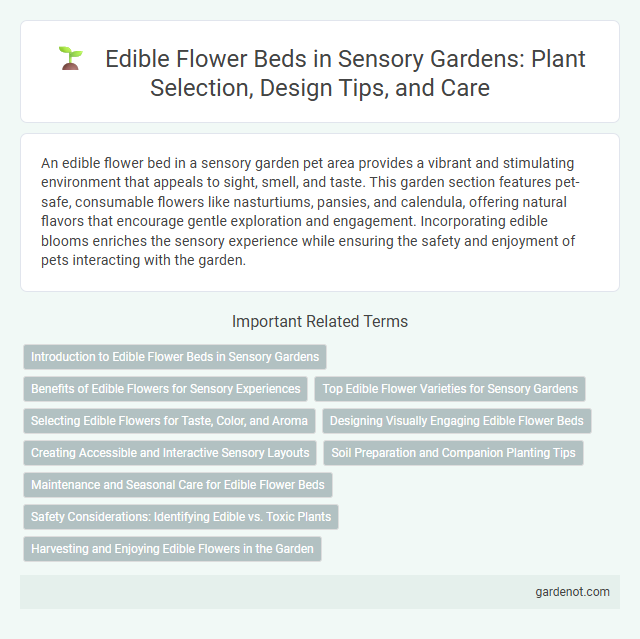An edible flower bed in a sensory garden pet area provides a vibrant and stimulating environment that appeals to sight, smell, and taste. This garden section features pet-safe, consumable flowers like nasturtiums, pansies, and calendula, offering natural flavors that encourage gentle exploration and engagement. Incorporating edible blooms enriches the sensory experience while ensuring the safety and enjoyment of pets interacting with the garden.
Introduction to Edible Flower Beds in Sensory Gardens
Edible flower beds in sensory gardens combine vibrant colors, enticing fragrances, and unique textures to stimulate multiple senses while providing fresh, edible blooms such as nasturtiums, pansies, and calendulas. These beds encourage interaction and education, allowing visitors to touch, smell, and taste flowers that enhance culinary experiences and promote sustainable gardening practices. Incorporating edible flowers supports biodiversity, attracts pollinators, and creates an engaging atmosphere that nurtures both sensory exploration and healthy eating habits.
Benefits of Edible Flowers for Sensory Experiences
Edible flower beds enhance sensory gardens by offering vibrant colors, unique textures, and diverse aromas that stimulate sight, touch, and smell simultaneously. Consuming edible flowers introduces a multi-sensory tasting experience, engaging taste buds with subtle flavors while promoting mindfulness and connection to nature. These flowers often contain antioxidants and vitamins, adding nutritional value to the sensory exploration.
Top Edible Flower Varieties for Sensory Gardens
Top edible flower varieties for sensory gardens include nasturtiums, pansies, and calendula, each providing vibrant colors and unique flavors that stimulate sight and taste senses. Nasturtiums offer a peppery taste, pansies add a mild, sweet flavor, and calendula petals contribute a tangy, slightly spicy note, making them ideal for culinary use. Incorporating these edible flowers enhances sensory engagement while supporting pollinators and biodiversity within the garden.
Selecting Edible Flowers for Taste, Color, and Aroma
Choosing edible flowers for a sensory garden involves evaluating varieties like nasturtiums, pansies, and calendulas for their vibrant colors, distinctive aromas, and unique taste profiles. Flowers such as lavender and chamomile add aromatic depth while enhancing visual appeal and flavor in salads or teas. Prioritizing non-toxic, pesticide-free blooms ensures safe and enjoyable sensory experiences with each harvest.
Designing Visually Engaging Edible Flower Beds
Designing visually engaging edible flower beds involves selecting vibrant, colorful blooms such as nasturtiums, pansies, and calendulas that attract pollinators and create dynamic patterns. Incorporating varied plant heights and contrasting textures enhances sensory appeal, while strategic placement near pathways invites close interaction and harvesting. Combining aesthetics with functionality ensures an edible flower bed that stimulates sight, smell, and taste in sensory garden spaces.
Creating Accessible and Interactive Sensory Layouts
Designing edible flower beds with wheelchair-accessible pathways and varied height planting ensures an inclusive sensory experience for all visitors. Incorporating tactile elements such as textured leaves and aromatic blooms enhances interaction, while clear labeling with Braille supports visual and non-visual engagement. Strategic placement of fragrant and colorful edible flowers stimulates multiple senses, fostering a dynamic and immersive garden environment.
Soil Preparation and Companion Planting Tips
Soil preparation for an edible flower bed requires rich, well-draining soil amended with organic compost to enhance fertility and moisture retention. Incorporating companion planting strategies, such as pairing marigolds with tomatoes or nasturtiums with beans, can deter pests and improve growth by promoting beneficial insect activity. Ensuring proper spacing and diverse plant selection supports a healthy ecosystem that maximizes both ornamental appeal and edible yield.
Maintenance and Seasonal Care for Edible Flower Beds
Regular maintenance of edible flower beds includes consistent watering, weeding, and monitoring for pests to ensure healthy growth and vibrant blooms. Seasonal care involves pruning spent flowers, adding organic mulch to retain moisture during dry periods, and enriching the soil with compost or balanced fertilizers in early spring and late fall. Adjusting care routines based on specific plant needs and local climate conditions optimizes yield and prolongs the flowering season.
Safety Considerations: Identifying Edible vs. Toxic Plants
When creating an edible flower bed in a sensory garden, it is crucial to accurately identify edible versus toxic plants to ensure safety for all visitors. Familiarity with common edible flowers like nasturtiums, pansies, and calendula helps prevent accidental ingestion of harmful plant parts. Implementing clear labeling and educating gardeners on proper plant identification further reduces risks associated with toxic species such as foxglove or belladonna.
Harvesting and Enjoying Edible Flowers in the Garden
Harvesting edible flowers in a sensory garden requires careful timing to ensure peak flavor and safety, typically during the morning hours when petals are freshest. Popular edible varieties such as nasturtiums, pansies, and calendula offer vibrant colors and unique tastes, enhancing salads, desserts, and herbal teas. Enjoying these flowers fresh or dried adds nutritional benefits and an aromatic sensory experience that delights both the palate and the senses.
Edible flower bed Infographic

 gardenot.com
gardenot.com